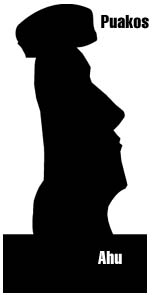

Stone statues called moai
carved from volcanic rock
Below, moai at Hanga Roa,
the island's only town.
(By Cliff Wassmann,
special to the Star-Bulletin)
THE AVERAGE MOAI
Height: 13.29 feet.
Width: 5.25 feet.
Width of head: 4.86 feet.
JUST THE BASICS
How: Carved with stone hand picks, primarily at Rano Raraku, a volcanic crater. Hundreds of statues in various state of production fill this moai graveyard.
When: Most of the work was done between 1400 and 1600.
Purpose: They represent the spirits of ancestors, chiefs or powerful male individuals. They also served as a spiritual link with various gods.
BY THE NUMBERS
Of the 887 moai located in a survey conducted by archeologist Jo Anne Van Tilburg, UCLA Institute of Archaeology, in 1989:
288 were successfully erected
397 remain in Rano Raraku quarry
92 were in the process of being moved to various locations.

SIZE DOES MATTER
The most notable moai found by archaeologist Jo Anne Van Tilburg are:
Largest: Named "El Gigante" at Rano Raraku quarry; 71.93 feet tall and weighing between 145 and 165 tons.
Largest standing: Named "Paro" at Ahu Te Pito Kura; 32.63 feet tall and weighing 82 tons.
Largest fallen: At Ahu Hanga Te Tenga; 33.10 feet tall.
MOAI CHARACTERISTICS
Pukaos: The top knot featured on some maoi. It is made from scoria, or cinderlike lava.
Ahu: With an average height of 4 feet, it is the flat mound or stone pedestal upon which a moai stands.
Sources: NOVA Online; World Book Encyclopedia; Polynesian Voyaging Society
ON THE WEB
Hokule'a: Follow the voyage of the Hokule'a at: http://leahi.kcc.hawaii.edu/org/pvs.
Easter Island: Photos were provided by Cliff Wassmann, who specializes in documenting sacred sites and ancient civilizations. More of his work can be seen at: http://www.mysteriousplaces.com